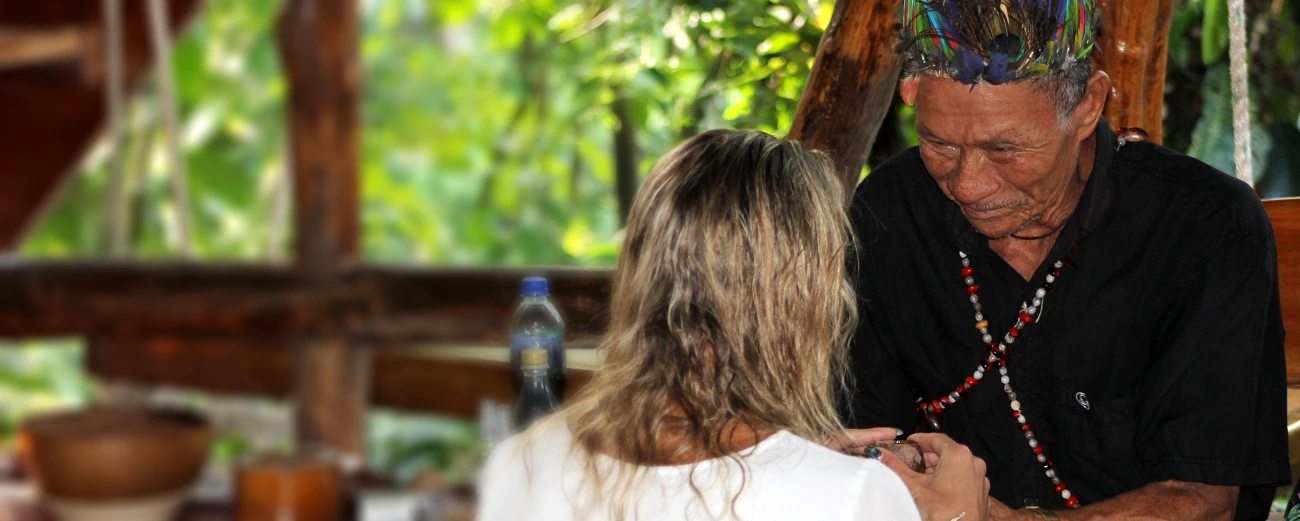How an Ayahuasca Ceremony Takes Place

The Ayahuasca ceremony begins at 7:00 PM after sunset. The images of the moon and the sun hold sacred meaning for the Incas, symbolizing the eternal dialogue between masculine and feminine, divine and demonic, day and night. Around the time of the sun and moon’s shift (6:30 PM), the curandero (healer) arrives at the ceremony site (Maloka), performing a preparatory ritual: donning his ceremonial attire, gathering the necessary tools for the retreat, energetically cleansing the space, and tuning in to determine his place. You may notice that he sat in one place at the previous ceremony, but today he sits in another. There’s no need to be surprised—he intuitively selects the area where he feels most comfortable working, based on his attunement to the retreat participants.
Beginning
At exactly 7:00 PM, participants gather for the Ayahuasca ritual. The curandero determines the order of serving Ayahuasca and the dosage for each person. Each participant approaches the maestro and sits on one knee, receives a small cup (pilche) of Ayahuasca, and drinks. Once the last participant has finished their cup, the curandero drinks his own.
Transition Phase
Three candles burn on the Ayahuasca ceremony altar, each one goes out after 13 minutes, leading to complete darkness after about 40 minutes. However, participants gradually lose track of time, an important aspect of the ritual. The maestro attunes to each participant, slowly uncovering the layers of their energy field, and the energetic work begins.
Main Phase of the Ayahuasca Ceremony
The third candle goes out. In the darkness, the outlines of plants and the maloka become faintly visible. Distant lanterns, and sometimes the bright moon, illuminate the dark sky. The hum of the river and insects blend into a unified “orchestra,” providing the soundscape for the Ayahuasca ceremony. After some time, you begin to understand that any additional sounds or instruments would be unnecessary. The maestro starts singing “icaros”—ancient sacred shamanic songs that invoke the spirits of nature and animals to join the Ayahuasca ceremony, accumulating energy. Interestingly, participants' descriptions sometimes align—several people might be seeing the space gradually filling with entities. This is referred to as collective vision.
Personal Energetic Work by the Curandero
This is the most crucial phase of the ceremony. It lasts about 20 minutes, but by this point, participants lose all sense of time. Memories are subjective: some feel the maestro worked with them for an eternity, while others feel it was only a second. Some may block this phase from their memory entirely. During this time, you can embark on a deep journey with the shaman through different realms—it all depends on how open you are to the process and your experience with entheogens. During the personal work, the maestro deeply penetrates your energyfield, observing what he will later share in his revelations after the ceremony.
Personal feedback is an essential part of the retreat
After the personal work, the shaman may continue the ritual by speaking softly, with brief pauses. This could be a prayer interspersed with information about you—what he saw in your biofield. Nearby, a translator carefully records the shaman’s words to ensure nothing is missed. These revelations are compiled and systematized by the end of the retreat and adapted to your understanding. The shaman may also decide to give additional Ayahuasca to some participants in the second part of the ritual. Participants can also request more Ayahuasca from the helper. The helper always asks the maestro for permission and never makes decisions on their own. A helper is always nearby. A psychologist who specializes in altered states of consciousness carefully monitors participants' behavior, speech, and emotional states. This is a crucial detail, as a person’s behavior under Ayahuasca can shed light on the root of their problems. Verbal contact with the psychologist during the ceremony can help rewrite unconscious systemic errors in the psyche, offering an extremely effective method that can replace years of “sober” therapy. Any panic or fear attacks during the ceremony are also quickly addressed by the specialist.
Conclusion of the Ayahuasca Ceremony
The Ayahuasca ritual takes place just a minute’s walk from your room. We prioritize your comfort, and the team ensures that each participant has the opportunity to retire to a warm bed during the “grounding” phase. However, if a person prefers to stay in the maloka in nature, that is entirely their choice. Sometimes the curandero may insist on escorting a participant back to their room, explaining that they need time alone. In such cases, it’s best to listen to the maestro.